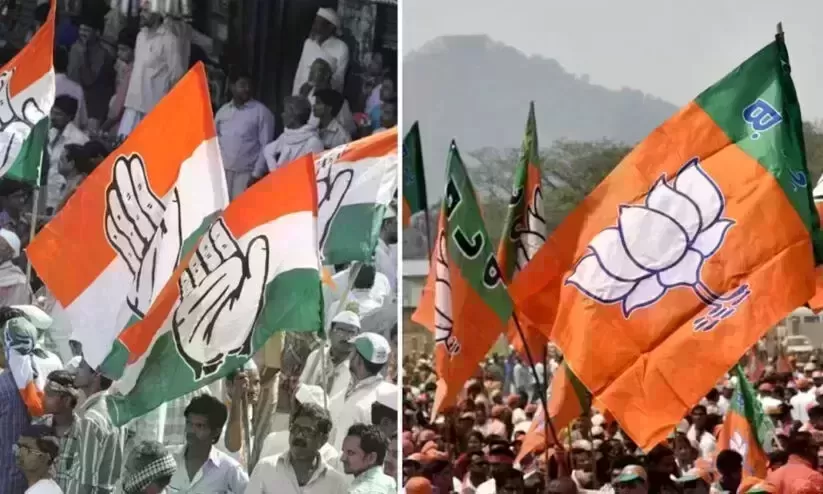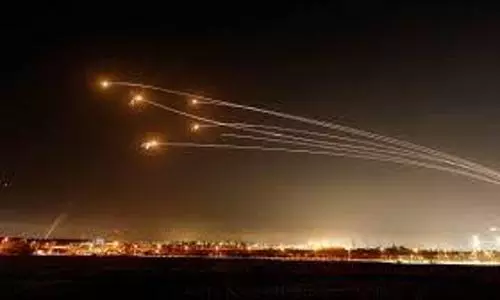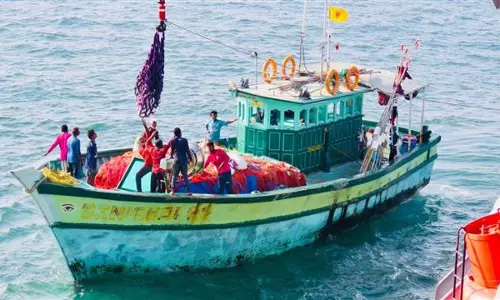
Journalism continues to be gagged in Kashmir
text_fieldsSyed Shahriyaar, an award-winning photojournalist in Kashmir (Image: Syed Shariyaar instagram account)
"As a photojournalist, it is more important to be on the road. If I don't do, No one does". says Syed Shahriyaar, an award-winning photojournalist in Kashmir working for over 10 years on the ground. Even as the intimidations and imposition of draconian laws on journalists in Kashmir continues, the stifling infringement leave them with no other options than to unveil the violations with a razor in front and a grip at their back anytime.
A Protest in 2011 in the Rajouri, the old city of Kashmir, turned violently remorseless and brutally victimized as the army opened pellet fire without any pity over the crowd. People ran around for their lives in six and seven and confronting death at the same time.
Many of the journalists including Syed Shahriyaar were not spared. They were chased, beaten up, and executed or taken to jails.
As he ran for his life followed by death at any moment with the army just behind him and climbing up the high tension transformers to escape, he knew it would be a risk worth taken and less dangerous than getting caught at the zero mercy of the army.
"It is extremely difficult for a journalist to be on the protestor's side while on the field" He admits. He landed at the back of a house, whose father was killed in 2010. There were 5-7 people inside and they heard sounds of people getting arrested outside.
It was a near-death escape and one among the many vis a vis arsons and cordons one witness right from his childhood.
While growing up as a kid, Syed as many of the children in Kashmir had memories of the army entering their houses during a CASO (Cordon And Search Operations). His home town, Hassanabad is few kilometers away from Jamia Masjid where the premises witness Friday protests for years.
In 2006 and 2007, the 14-year-old along with his generation saw the armed forces shut opening their doors terrifyingly on January 26 and August 15 while rest of the India celebrated in complacency.
Being in the midst of stringent army surveillance and human rights violations, Syed Shahriyaar also grew up witnessing stone-pelting and protests which had been the common way of demanding their rights to exist in dignity and to assert Kashmiris' survival through resistance.
When a public park in Bijbehara was ruthlessly turned into a graveyard in 1993, the media suffered a complete blackout after the news was brought to the limelight. And with the ongoing unethical detentions and custodial harassments of journalists like Asif Tanha and Irfan Amin Malik, or with the imposition of draconian laws, the journalists and photojournalists in Kashmir have to constantly put up with the belligerence of the army then and now.
As Kashmir is threatened with the most number of the army deployed than anywhere in the world, media restrictions and threats on journalists are further alienating the state, shrouding its human rights violations. And without these brave people coming to the forefront risking their lives, most of the infringement in the lives of Kashmiris have remained unknown to the outside world.
Recollecting the Past
Hailing from a family of poets, teachers, and writers, Syed grew up hearing his grandfather, Akbar Jaipuri's poems which are frequently recited in protests, and by witnessing the conflicts in streets and violence of the army within their own homes. Syed Shahriyaar has not only came across the events and shifts in Kashmir for more than 10 years but collected, captured, and stored them both in his memory and camera.
"The images are blurred but the memories are sharp" He says.
In 2008, following the Amar Nath Land Row, many young boys were killed in marches and agitations against the movement of the shrine board in confiscating acres of land in Kashmir for Amar Nath pilgrimage.
He started collecting pictures of conflicts and their victims from local newspapers and organized them. In 2014, his 'Witness Book' was complied by Sanjay Kark and was featured among nine of the photographers, who told the stories of Kashmir through their lenses.
Later on, the urge to capture the truths brought him bravely to the streets and his camera had been since, clicking several of the funeral protests, encounters, and the anxious, helpless people struggling in the midst of occupation.
Confronting first-hand experiences to capture, and with the desire to share the truths to the world, he walked across over 40 km to complete his bachelors in Mass media and Multimedia from Baramullah college in Kashmir, passing by many military camps pitched on both sides of the road, all along. More precisely the truths and reality of Kashmir and their daily struggles and conflicts were explicitly reflected through the eyes and tears of Kashmiris he captured.
Following the assassination of Sheikh Abdul Aziz during 'Mussafrabad Chalo' (let's go to Mussafrabad) on August 9, 2008, Syed wrote a reminiscent piece titled' Remembering Aziz' in 'Greater Kashmir', one of the leading newspapers in Kashmir.
Recalling his memories with Tufail Mattoo, a 17-year-old boy who was ruthlessly shot at the head while on his way to home from his entrance examination classes, Syed says, " We boarded a bus to school together and we were neighbors. His murder triggered massive protests and hundreds of them were responded with death by the army.
On Tufail Mattoo's 10th death anniversary, Syed Shahriyaar published a news story on his father in 'Independent Urdu', who had then been visiting his son's graves where his body and head are buried in two different places.
India's Arbitrary New Media Policy for Kashmir
The 53-page document of the New Media Policy for Kashmir will be enforced for the next five years and will turn out journalism into a mouthpiece of Government and dismantle the pillars of democracy. As per the new policy, a Govt. An official or a bureaucrat can decide what is news and what should not be. They can take any legal action against journalists and publishers for publish that which does not fall into their 'news versions'. By this, the Government can arbitrarily look into the content and halt any news published against the Government.
The Media Policy which is the last nail in the coffin also emphasis on conforming to the antecedents of newspaper publishers and editors before qualifying News media to advertisements in print as well as in online portals.
Despite an outcry of journalists against the policy it is not only rolled back but continues to enforce its legal moves against journalists and publishing media. 'The Kashmir Times', one of the oldest Publishing Media House has been recently sealed by the Jammu&Kashmir Police. Anuradha Bhasin, the editor of 'Kashmir Times' had earlier filed a petition in the supreme court against the ongoing communication blockade in the valley. The New Media Policy turns out to be the last nail in the coffin for Journalism in Kashmir.
Being a journalist in Kashmir
Being a journalist in Kashmir, you are frequently subjected to routine checks by the police force and nothing less than constant intimidations and arrests upon UAPA or pre-planned attacks.
Following the revocation of Article 370 on August 5, 2019, he worked with several teams in different international organizations reporting the atrocities and had to even go into hideouts or move away from his home town as the forces sent in for a look out.
The Indian Government has recently amended Kashmir's Media Policy to make sure that the Press is further crushed and does not pose any stance against the administration.
"Life of a Journalist in Kashmir is uncertain and threatened. Even this day as I am speaking, two of the journalists were beaten up while covering the stories of the election," says Irfan Amin Malik, the first Kashmiri journalist who got detained after the abrogation of Article 370.
The challenge is to enter the conflict zones irrespective of the assaults and false charges from the forces daily. There is trouble and stress dragging along their backs each moment they spend on the ground.
Apart from the harassment of the forces, he says they undergo psychological pressures from the people who sent for warnings and gossips that the forces are checking on him for shooting the incidents.
The alienation by the persisting uncertainty among people who fear that they are teachers to the army during the protests and encounters are other factors which put them mental dilemmas, but to which Syed Shahriyar responds,
"If I don't do, no one does."
By now, more than five journalists including Masrat Zahra and Peerzada, and Ashiq along with senior journalist Gowhar Geelani were charged with UAPA (Unlawful Activities Prevention Act) after the striking of Article 370, and photojournalists like Kamran Yousuf and other local reporters continue to struggle under threats and assaults from the Forces. Journalists are still continued to be called on by the Police. Appearing before the stations and narrating their news stories several times have become a routine for the journalists in Kashmir.
Even after risking their lives by reporting the human rights violations and atrocities of the army, taking the sources out of Kashmir and letting the world know is another Hercules task to overcome. Often journalists are selected in particular and enforced to special checking and they even had to find opportunities to send in the sources through other visitors in and out of Kashmir.
Journalism as a career
"Initially I thought, I would be a writer as my family had roots of writers." He says with a streak of excitement recollecting his career journey. But the desire to photograph the reality was always planted in him and he chose to be on the streets more than to be in the classes.
"As a photojournalist, it is more important to be on the road," He says.
In 2013, his capture of few children bathing in a pool from the outskirts during Ramzan got featured in the light box of 'Korbis' among the 50 pictures of the week from renowned photographers around the world. He has also done news stories for 15 to 30 international news organizations over the protests in Saudi Arabia that broke out following the murder of a Shia clerk. Before joining for a diploma in visual photography, he had a bunch of bylines and on-field experiences.
It was the harbinger to his career followed by the recognition in 'Witness Book' of 2014 by Sanjay Kark. Syed Shahriyar has worked with many experienced photographers from a young age and his works were published in various eminent international news organizations, local and online news portals within Kashmir.
Syed was also part of the creative shifts that waved across the universities in Kashmir and was featured among other artists in a documentary, 'In the Shade of Fallen Chinar' shot by N.C Fazil. There were paintings, music and art installations depicting the conflicts in Kashmir. From 2017, he also undertook video assignments for rap songs and other creative endeavors while pursuing his career.
Irfan Amin Malik says that Journalism as a career in Kashmir is not too promising in all aspects, including satisfying one's financial requirements. An aspiring media student with dreams of picking up cameras and strolling into the streets is thwarted away in the impunity of the army. They are troubled, assaulted and their cameras are ceased and snatched away. "Life as a journalist in Kashmir is not peanuts in bed, it's full of thorns around". He adds
As Irfan says, It is not possible to write anything out of the box other than that favoring the government and posing a blind eye to many of the torments. News in Kashmir is constantly censored and filtered.
Covering militant funerals and other stories of deprived lives
While doing his Masters in Mass Communication and Journalism from Kashmir University, he went on to shoot the militant funeral of Burhan Wani in 2016. A year which marked the shift in the course of militancy in Kashmir and an air uncertainty stagnated among the people. And they did not allow photographers to shoot fearing they are army agents.
Shahriyar was forced to take pictures in his cellphone among thousands of Kashmiris flooding in to see the funeral and their martyr for the last time.
On the way back people including police officers asked him to show the clicks.
"Till yesterday, he was a traitor and today he is a martyr of his homeland." Syed recollects the words of a police officer.
In 2020, he shot the story of a mother of a militant for 'Vice' who travels across 60km to visit her son's unidentified graveyard. Shakoor Farooq Langoo, a 19-year-old was killed in a battle with the forces and his body was buried in an unknown grave without handing it over to the families.
The video portrays the anticipations and helplessness of a mother and clearly addressing the oppression Kashmiris have been facing for decades.
Humanity is the priority
Syed recollects an incident, a few years back on an Eid day while capturing the army attacks to his own people, being on the troupe's side. The tear gas from one of the soldiers got itself burst from his own gun wounding his hands.
"You are in the forefront to capture the truths and journalism is about humanity. One is trying to disclose the truths, being the sentinel of democracy and freedom. I should help him, it's about humanity that matters anywhere and I helped him to tie his hands with a handkerchief." Recalls Syed Shahriyaar.
With the subsequent media& communication blackouts, encroachment on the ethics and rights to journalism, the perils of army occupation in Kashmir will be less known and life in Kashmir will confront further balks if the attacks on journalism continue.
The validation of restrictions on journalism in Kashmir should receive responses from international media as well that in addition to the abrogation of the rights of a state, the Govt. forces are also trying to conceal and twist the incidents and halting the works of journalism.
The events of 10 years in the history of Kashmir, shows that the only means of portraying the truths in Kashmir are not brought forth by the UN, but by the journalists and photojournalists working in Kashmir, experiencing the truths and timely informing of news and events.
There is no resolution for the human rights violations and atrocities to Kashmiris when a report collecting the number of deaths in 5-6 years is done or by examining the percentage of pellet attacks after every form of remorseless actions are done to the millions of civilians and looting their lands, privacy, and freedom. The stringent amendments of the Government and all evading surveillance into the privacy of professional journalists and halting the operations of the media seek to put an official and 'legal' end to democracy.
Therefore unbiased and timely interferences and attention from global media are necessary to ensure, check, and keep the democracy alive, especially in conflict zones like Kashmir swirling under occupation.























